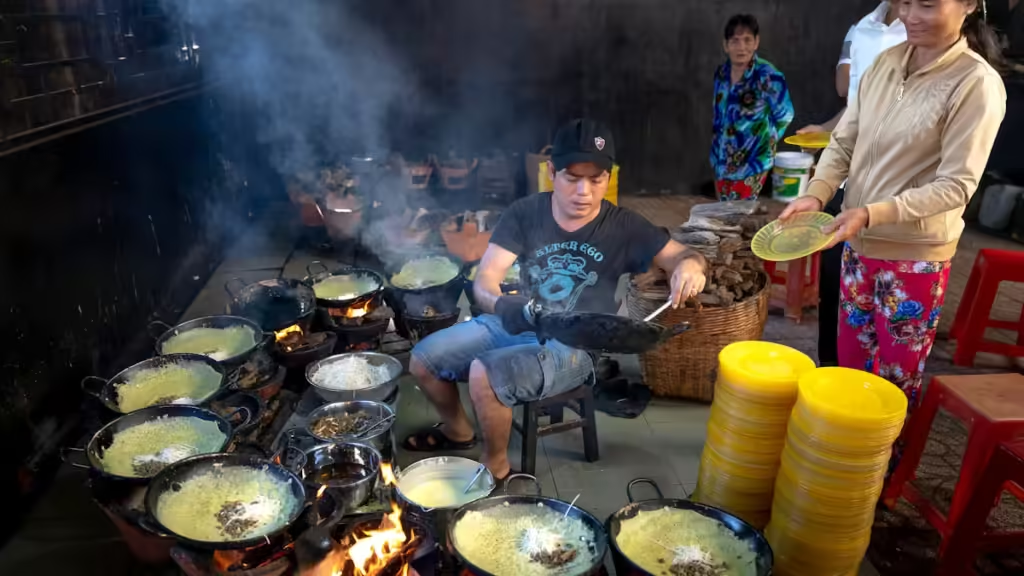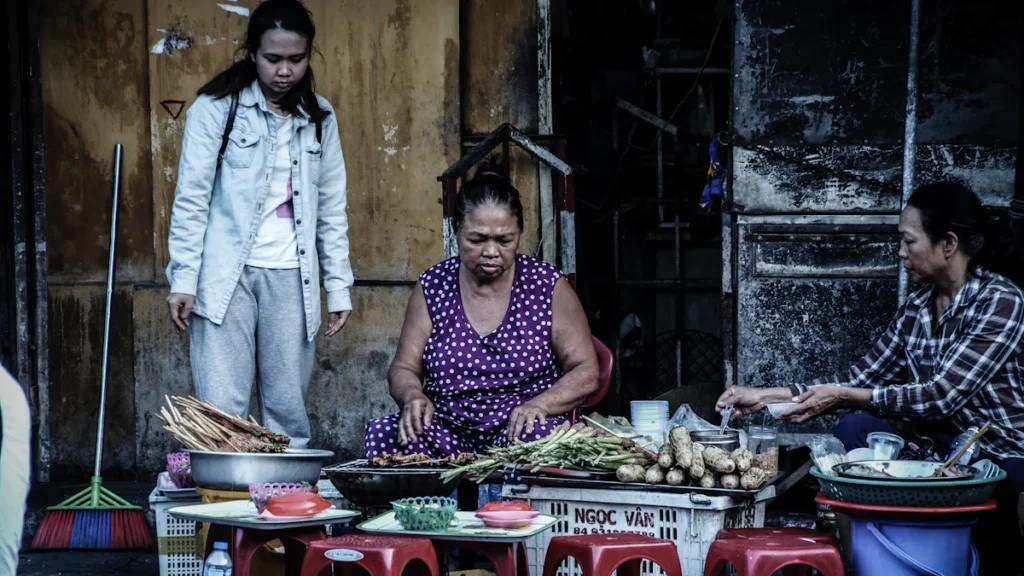Hoi An’s Top 5 Street Foods You Can’t Miss
Hoi An’s street food culture bursts with vibrant flavors and rich history. Exploring local street foods offers a deep dive into the city’s culinary heritage. Each bite tells a story of cultural fusion, from Chinese to French influences. The bustling streets and alleyways invite food lovers to savor unique dishes. Discovering the 5 Must-Try Street Foods in Hoi An promises an unforgettable gastronomic adventure.
5 Must-Try Street Foods in Hoi An

Banh Mi
What is Banh Mi?
Banh Mi, a Vietnamese sandwich, combines a French baguette with local ingredients. The bread is thin and crunchy, filled with pork, fried eggs, pate, or chicken. Fresh vegetables like lettuce, cucumbers, pickled carrots, and coriander add a unique touch.
Unique ingredients and flavors
Banh Mi offers a perfect blend of spicy, salty, sweet, and crispy textures. Homemade tangy sauce enhances the flavors. Each bite delivers a balanced taste experience.
Famous Banh Mi stalls in Hoi An
Hoi An boasts several renowned Banh Mi stalls. Banh Mi Phuong on Phan Chu Trinh Street is a must-visit. Banh Mi Queen, another popular spot, offers a memorable experience with its legendary owner.
Tips for finding the best Banh Mi
Seek out stalls with fresh ingredients and a steady stream of locals. Avoid places with pre-made sandwiches. Ask for recommendations from locals or fellow travelers.
Origins of Banh Mi
The French introduced the baguette to Vietnam during colonial rule. Over time, locals adapted it into the iconic Banh Mi sandwich. This culinary fusion reflects Vietnam’s rich history.
Evolution of the dish in Hoi An
Hoi An’s Banh Mi stands out due to its generous use of fresh vegetables. The city’s unique take on this dish has earned it a reputation as the best Banh Mi in Vietnam.
Cao Lau
What is Cao Lau?
Cao Lau is a noodle dish unique to Hoi An. It features thick rice noodles, slices of pork, fresh herbs, and crispy croutons. A small amount of broth adds flavor without overwhelming the ingredients.
Unique ingredients and flavors
Cao Lau’s distinct taste comes from its special noodles, which are soaked in lye water from local wells. The combination of tender pork, fresh greens, and crunchy croutons creates a delightful texture contrast.
Popular spots for Cao Lau in Hoi An
Visit Ba Le Well or Cao Lau Thanh for an authentic experience. These spots are known for their high-quality ingredients and traditional preparation methods.
Tips for finding authentic Cao Lau
Look for places that use well water and lye-soaked noodles. Authentic Cao Lau should have a balanced mix of textures and flavors. Avoid overly soupy versions.
Origins of Cao Lau
Cao Lau’s origins trace back to Hoi An’s trading port days. Chinese and Japanese influences shaped this dish, making it a unique part of the city’s culinary heritage.
Cultural significance in Hoi An
Cao Lau represents Hoi An’s historical connections with other cultures. The dish embodies the city’s rich past and its role as a melting pot of culinary traditions.
White Rose Dumplings (Banh Bao Vac)
What are White Rose Dumplings?
White Rose Dumplings, or Banh Bao Vac, are delicate dumplings made from translucent rice paper. They are filled with shrimp or pork and topped with crispy shallots.
Unique ingredients and flavors
The dumplings’ thin, chewy skin contrasts with the savory filling. A dipping sauce made from fish sauce, lime, and chili adds a tangy kick.
Best places to eat White Rose Dumplings
Try White Rose Restaurant for the best experience. This family-run establishment has perfected the art of making these dumplings.
Tips for enjoying this delicacy
Savor the dumplings with the dipping sauce to enhance the flavors. Pair them with a cold drink for a refreshing meal.
Origins of White Rose Dumplings
A local family in Hoi An created White Rose Dumplings. The recipe has been passed down through generations, making it a cherished local specialty.
How they became a Hoi An specialty
The unique preparation and presentation of White Rose Dumplings have made them a symbol of Hoi An’s culinary creativity. The dish’s popularity continues to grow among locals and tourists alike.
Com Ga (Chicken Rice)
What is Com Ga?
Com Ga, or Chicken Rice, stands as a beloved dish in Hoi An. This meal features tender chicken served over fragrant rice, cooked in chicken broth. Fresh herbs and a side of pickled vegetables complete the dish.
Unique ingredients and flavors
Com Ga boasts unique flavors from its ingredients. The rice absorbs the rich chicken broth, giving it a savory taste. Fresh herbs like cilantro and mint add a refreshing touch. Pickled vegetables provide a tangy contrast.
Top spots for Com Ga in Hoi An
For the best Com Ga, visit Com Ga Ba Buoi on Phan Chu Trinh Street. Another popular spot is Com Ga Hien. Both places offer authentic and delicious versions of this dish.
Tips for finding the best Com Ga
Look for stalls with a high turnover of customers. Fresh ingredients are key to a good Com Ga. Ask locals for their recommendations. Avoid places with pre-cooked chicken sitting out for long periods.
Origins of Com Ga
Com Ga has roots in Chinese cuisine. Traders brought the dish to Hoi An centuries ago. Over time, locals adapted it, adding their own twists and flavors.
Its role in Hoi An’s culinary scene
Com Ga plays a significant role in Hoi An’s culinary scene. The dish reflects the city’s history as a trading port. It showcases the blend of local and foreign influences that define Hoi An’s food culture.
Mi Quang
What is Mi Quang?
Mi Quang is a noodle dish native to Quang Nam Province. It features thick rice noodles, shrimp, pork, and fresh herbs. A small amount of broth enhances the flavors without making it soupy.
Unique ingredients and flavors
Mi Quang’s unique flavors come from its ingredients. Turmeric gives the noodles a yellow hue. The dish includes peanuts, sesame rice crackers, and fresh herbs. A hint of lime juice adds a zesty kick.
Renowned places for Mi Quang in Hoi An
For an authentic experience, visit Mi Quang Ba Mua. Another great spot is Mi Quang 85. Both places are known for their high-quality ingredients and traditional preparation methods.
Tips for enjoying Mi Quang
Enjoy Mi Quang by mixing all the ingredients well. The dish should have a balance of textures and flavors. Add extra lime juice or chili for a personal touch. Avoid places where the broth overpowers the other ingredients.
Origins of Mi Quang
Mi Quang originated in Quang Nam Province. The dish reflects the region’s agricultural bounty. Locals created it using readily available ingredients like rice, shrimp, and pork.
Importance in local cuisine
Mi Quang holds a special place in Hoi An’s local cuisine. The dish represents the simplicity and richness of central Vietnamese food. It showcases the use of fresh, local ingredients and traditional cooking methods.


